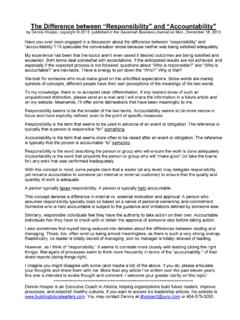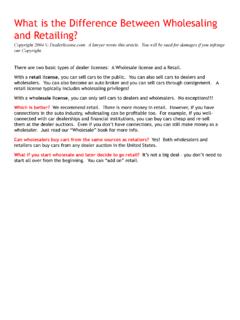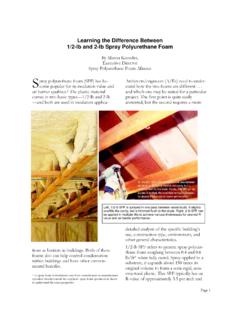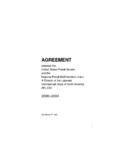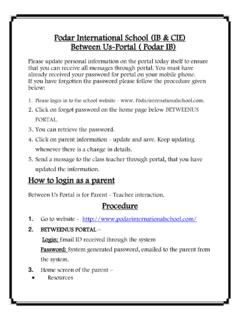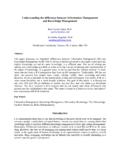Transcription of The Relationship Between Soil and Water - Soils …
1 The RelationshipBetween soil and WaterHow soil Amendments and CompostCan Aid in Salmon RecoveryFall 1999 Abstract: soil degradation and Water pollution are widely recognized as major environ-mental problems. Less widely recognized is that soil and Water are interconnected. Soilsfor Salmon is a project promoting the conservation of native Soils and improvement of disturbed Soils . Soils for Salmon supports salmon and other species recovery and is con-sistent with many other efforts to minimize the human impact on the natural byJosh Marx(206) 296-4429 King County Department of Natural ResourcesAndy Bary(253) 445-4588 Washington State University - PuyallupSego Jackson(425) 388-6490 Snohomish County Public Works Solid Waste Management DivisionDavid McDonald(206) 684-7650 Seattle Public UtilitiesHolly Wescott(360) 407-6113 Washington State Department of EcologyGraphic SupportLaurel PrestonKing County Department of Natural ResourcesJeff BreitensteinKing County Department of Natural ResourcesOther SupportThe authors wish to thank many others from within their jurisdictions as well as Phil Cohen, City ofRedmond, Dr.
2 Derek Booth, University of Washington Center for Urban Water Resources Management,Douglas Beyerlein, Aqua Terra Consultants, Lise Glaser, Cascadia Consulting Group, and Connie Allison,Administrative Director of the Washington Organic Recycling byKing County Department of Natural Resourcess201 South Jackson Street, Suite 700 Seattle, Washington 98104(206) 296-4429; 1-800-833-6388 TTY the Soils for Salmon website material is available in alternate formatsupon request for individuals with Relationship Between soil and Water How soil Amendments and Compost Can Aid in Salmon RecoveryPage 1 Executive SummarySoils for Salmonis a project of the Washington Organic Recycling Council (WORC) designed to increase awareness ofsoil improvement as a means to support salmon and other species recovery. A goal ofSoils for Salmonis for local gov-ernments to develop Best Management Practices that conserve native Soils and improve disturbed Soils .
3 soil degradation and Water pollution are widely recognized as major environmental problems; Healthy Soils directly contribute to healthier Water resources and thus indirectly support salmon; Steps taken to improve Soils lead to improved Water quality and quantity that will result in healthier fish habitat; Increased use for compost helps close the recycling loop through beneficial use of organic healthy soil provides a number of vital functions including the ability to store Water and nutrients, regulate the flowof Water , and immobilize and degrade is the product resulting from the controlled biological decomposition of organic waste (such as yard debris,food waste, soiled paper, wood waste, biosolids and manures). Compost has the ability to bring back many critical func-tions to urban Soils , which have lost their ability to hold and retain Water , and bind as the retention of forest cover has been recognized as a land use tool for managing Water quality and Water vol-ume, it is critical that soil structure retention be considered as a tool in the regulatory and land use tool box.
4 Becausesalmon and other fish species rely on clean, fresh Water to survive, they equally need healthy soil in the watershed for Salmonchallenge is to implement a strategy designed to improve soil health. The goal is to improve thecharacteristics of urban soil to perform more like a native soil so that a more vibrant diversity of organisms will thrive,healthier plant growth will be sustained, and air and Water will be held and retained of Soils for Salmonsupports salmon and other species recovery efforts at the same time helping sup-port agricultural viability and recycling organic waste into beneficial uses. Each of these helps to move the PacificNorthwest in the direction of a more sustainable future through healthier soil and 2 The Relationship Between soil and Water How soil Amendments and Compost Can Aid in Salmon RecoveryTable of ContentsExecutive Summary.
5 1 Definitions .. 3 Introduction .. 4 Purpose of Soils for Salmon .. 5 The Importance of soil , How it Functions and its Effect on Water Resources .. 5 The Human Impact on Soils and its Effect on Habitat .. 8 The Story of Compost .. 11 Development of a Healthy soil Strategy .. 12 Conclusion .. 17 Endnotes.. 18 Tables and FiguresFigure 1 Healthy Habitat Features and soil Amendments.. 4 Figure 2 Healthy soil Functions .. 5 Figure 3 Native soil .. 6 Figure 4 Disturbed soil .. 7 Figure 5 Typical Landscape Practice .. 8 Table 1 Where average annual rainfall of inches goes .. 9 Figure 6 Where the Rain Goes .. 9 Figure 7 The Story of Compost .. 11 Figure 8 Utilization of Best Management Practices .. 13 Figure 9 Magnified view of disturbed and native soil .. 17 The Relationship Between soil and Water How soil Amendments and Compost Can Aid in Salmon RecoveryPage 3 Definitions1.
6 Compost The product resulting from the controlled biological decomposition of organic Disturbed soil Soils that have been impacted through urbanization and human Organic Materials (waste) Materials that are not typically wanted by their producer. Examples include foodwaste, yard debris, soiled paper, wood waste, biosolids and Native soil soil that has been undisturbed by Nematodes Microscopic worm-like organisms primarily soil borne and not related to Protozoa Microscopic single celled soil aggregates A group of soil particles adhering to each other that form the soil soil amendment Any material such as compost, lime, animal manures, crop residues etc. that is worked intothe soil . Generally pertains to materials other than soil Foodweb The soil foodweb is a complex system made up of microscopic and macroscopic organisms suchas bacteria, fungi, nematodes and protozoa.
7 These organisms provide vital functions by keeping disease-causingorganisms in check, helping to cycle soil nutrients, allowing healthy root growth and providing a highway for airand Water to pass soil organic matter That portion of soil that contains carbon in the form of decayed plant and animal residues(undecayed plant and animal residues are not soil organic matter).11. soil structure The combination of soil particles into secondary aggregates. Examples are platy, prismatic, blockyor spherical. Compost helps bind primary soil particles to improve soil soil texture The combination of the different soil particles of sand, silt and clay. Example: silt loam contains >50% silt and 12-27 % clay and <28% WORC The Washington Organic Recycling Council is a nonprofit corporation formed to support the growingindustry engaged in recycling of organic 4 The Relationship Between soil and Water How soil Amendments and Compost Can Aid in Salmon RecoveryIntroductionIn the wake of the National Marine Fisheries Endangered Species Act listing of Chinook salmon, more than 200 profes-sionals gathered at the Center for Urban Horticulture at the University of Washington for the firstSoils for Salmon, TheUrban Environmentseminar.
8 Led by the Washington Organic Recycling Council (WORC)i, the seminar addressed therelationship Between urban Soils , hydrology and salmon habitat. The March 31st event was well attended and widelyacclaimed as providing a needed recognition for the soil / Water interconnection concept. This concept includes severalideas that combine to form a unifying theme: soil degradation and Water pollution are widely recognized as major environmental problems; Healthy Soils directly contribute to healthier Water resources and thus indirectly support salmon; Steps taken to improve Soils will improve Water quality and quantity that will result in healthier fish habitat; Increased use for compost helps close the recycling loop through beneficial use of organic ideas have also provided a central theme or umbrella for a coalition of agencies, individuals and private enter-prise to organize.
9 Simply stated, there is interconnection Between soil quality and Water quality and healthy waterresources. But healthy Soils do far more than help 1. Healthy Habitat Features and soil AmmendmentsHealthy habitat is one critical component to salmon recovery. soil amendments provide many benefits as depicted of these benefits directly coincide with characteristics of a healthy habitat. The arrows point to those soil amendmentbenefits that can help salmon by improving Water quality and quantity. From this it is clear why proper soil managementshould be considered as another tool in the regulatory and land use tool-box to support Salmon paper discusses the function of Soils , their Relationship to Water , the human impact on Soils , and how disturbedsoils can be improved. It takes a preliminary look into actions local and state governments can begin to make to protectsoil health and salmon habitat.
10 Now is the opportunity to focus on improved soil as an additional management tool,given the current attention to endangered species in the Pacific Habitat FeaturesGood Water Quality Cool Water temperatures No pollutants from runoff Minimized fine sediment (silt)Good Water Quantity Higher flows in the summer Reduced floodingImproved Stream Habitat Features Woody debris, Pools & Gravel sizeRemoval of Migration Barriers Culvert replacementSoil AmendmentBenefits Provide plant nutrients Increase Water holding andretention capacity Increase pollutant binding properties Improves aesthetics Landscaping savings}{How SoilAmendmentsHelp Salmon Decrease runoff Increase soil stability Less pesticide/fertilizeruse required Binds pollutants Natural filtrationThe Relationship Between soil and Water How soil Amendments and Compost Can Aid in Salmon RecoveryPage 5 Purpose of Soils for SalmonSoils for Salmon crosses a wide variety of disciplines including hydrology, soil science, waste management, agriculture,development, and landscaping.
